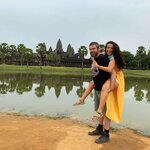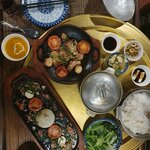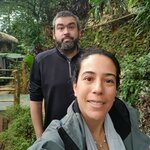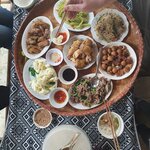Highlights
- Discover the sights, sounds, and flavors of Hanoi
- Visit the Gulf of Tonkin and cruise gorgeous Hạ Long Bay
- Tour Ho Chi Minh City and travel up the Mekong Delta
- See the highlights of Bangkok and take a Thai cooking class
- Spend the day at historic temples in Chiang Mai
Brief Itinerary
| Day | Highlights | Overnight |
|---|---|---|
| Day 1 | Arrive in Hanoi | Hanoi |
| Day 2 | Hanoi City Tour | Hanoi |
| Day 3 | Hanoi to Hạ Long Bay, Trinh Nu Cave | Halong Bay |
| Day 4 | Cave Tour, Transfer to Hanoi, Fly to Da Nang & Hội An | Hoi An |
| Day 5 | Walking Tour of Hội An | Hoi An |
| Day 6 | Hội An Cycling & Kayak Tour | Hoi An |
| Day 7 | Hội An to Ho Chi Minh City, Night Vespa/Food Tour | Ho Chi Minh City |
| Day 8 | Ho Chi Minh Guided City Tour | Ho Chi Minh City |
| Day 9 | Day Trip on the Mekong Delta | Ho Chi Minh City |
| Day 10 | Fly from Ho Chi Minh City to Bangkok, City Tour | Bangkok |
| Day 11 | Cooking Class in Bangkok | Bangkok |
| Day 12 | Day Trip to Ayutthaya & Night Train to Chiang Mai | Chiang Mai |
| Day 13 | Arrive in Chiang Mai, City & Temples Tour | Chiang Mai |
| Day 14 | Fly from Chiang Mai to Bangkok, Depart |
Detailed Itinerary
Day 1: Arrive in Hanoi

Welcome to Vietnam! Upon arrival at Hanoi's airport, you'll transfer by private vehicle to your four/five-star hotel for check-in. No doubt you'll be tired after the long journey, but after taking some time to relax and unwind you should head out and explore on foot. This modern yet traditional metropolis is well worth it.
Dating to 3,000 BCE, Hanoi is one of the most ancient capitals in the world. That said, it's a mix of the old and the new—a city defined by the contradictions of a rapidly developing yet deeply traditional society. Here glimmering office buildings sit alongside the French colonial Old Quarter. Rarely at rest, the kinetic energy of Hanoi's motorbike-packed streets spills over into the outdoor markets, Hang Gai silk shops, curbside bún chả /bánh mì vendors, and eclectic nightlife scene.
You can start your walk on the streets of Old Town, visiting markets and street vendors, and then take in some local history and mythology with a stroll around Hoàn Kiếm Lake. At the north end of the lake is an arched red bridge leading to Jade Island and the Temple of the Jade Mountain. This temple was built in the 18th century to honor Tran Hung Dao, a military commander who famously repelled two Mongol invasions.
Nearby, in the center of the lake, is Turtle Tower, a small stone tower built to commemorate the Golden Turtle God, Kim Qui, who, according to Vietnamese myth, reclaimed a magical sword from Emperor Lê Lợi in order to return it to the Dragon King. You should know that it's legends like these around which Vietnam's rich culture is based. After a brief walk and taking in Hanoi's famous sights, feel free to dine out in Old Town. There's no shortage of incredible eateries in this neighborhood that run the gamut from delicious street food to fine dining to trendy fusion restaurants.
Day 2: Hanoi City Tour

In the morning you'll embark on a comprehensive tour of Hanoi's most famous landmarks. It begins with a bicycle ride around the iconic Hoàn Kiếm Lake, located in Hanoi’s center. Then it's off to the Temple of Literature, which was built in the 11th century and is dedicated to Confucius. This temple was the first university in Vietnam, and it's still a place where students burn incense and pray at altars for academic success.
From there, you'll walk to a nearby park home to iconic city landmarks. One is the Lenin Statue, which commemorates Vietnam's communist past. Opposite the statue is the Flag Tower of Hanoi, an icon of the city that was once part of the Imperial Citadel. The citadel itself was first built during the Lý Dynasty of 1010, but most of it was destroyed by French imperialists during the conquest of Hanoi. Head to the top and you'll be treated to great views of the city.
Then you'll visit the Vietnam Military History Museum. Also known as the Army Museum, it houses an extensive collection of weaponry, artifacts, photographs, and vehicles from the Vietnam War. Notable attractions include the wreckage of an American B-52 bomber, an M107 artillery gun, and the very military tank that burst through the gates of Saigon’s Presidential Palace, signaling an end to the war in 1975.
After the Army Museum, you'll head back to the center and visit the Old Quarter. Tucked away amid these historic streets is Train Street, a narrow pedestrian throughway that runs by train tracks. Far from being in disuse, a couple of times a day a train actually passes through this street, right alongside residences and cafés, with just a foot or two of clearance on each side.
When lunchtime rolls around, you're in for a treat as you'll get to sample one of the culinary staples of Hanoi: bún chả. It's a dish of grilled fatty pork and rice noodles in a rich broth with fresh herbs. Later in the afternoon, you'll head to the north of the city, hop on an electric golf cart, and cap the day with an hour-ride around West Lake. It's a pleasant ride that includes a stop at Tran Quoc Pagoda, the oldest Buddhist temple in Hanoi.
Day 3: Hanoi to Hạ Long Bay, Trinh Nu Cave

After breakfast, you'll depart your hotel in Hanoi for the drive to Hạ Long Bay. This UNESCO World Heritage Site is one of the true natural wonders of the world. In this sweet spot where the land meets the Gulf of Tonkin, over 1,000 karst islets rise above emerald waters and the seascape takes on an otherworldly quality. The eastward drive from Hanoi takes about four hours, and you'll arrive at the port at about noon. Here you'll board a pleasure boat for an unforgettable overnight cruise along the bay. After a welcome aboard the ship, you'll be led to your cabin followed by a short trip briefing.
Once the ship gets underway, you'll enjoy a lunch of fresh seafood. The journey passes by some stunning sights including unique karts islets like Trong Mai and the floating fishing village of Cua Van. The first destination is Trinh Nu Cave. It's massive, covering an area of over 21,000 square feet and featuring a wide array of stalactites and stalagmites. That's not all, though; after hiking the cave you'll hop in a kayak and paddle around the emerald waters fronting the white sands of gorgeous Trinh Nu Beach.
You'll return to the boat just in time to watch the incomparable sunset from the top deck before sitting down for a dinner of more delicious, fresh seafood. Afterward, you can retire to your cabin for the evening or join the staff for a bit of night squid fishing.
Day 4: Cave Tour, Transfer to Hanoi, Fly to Da Nang & Hội An

Begin your day with a Tai Chi session on the cruiser's sundeck accompanied by complimentary tea and coffee. It's the perfect locale to integrate your mind and body as the sunrise over the bay compliments this internal martial art perfectly. With a rejuvenated spirit and newly healthy qi (life energy), you'll sit down for a light breakfast to be served on board.
After eating, the boat will weigh anchor and sail to Sung Sot Cave. At over 30,000 square feet, this is Hạ Long Bay's largest and most famous cave. There are two massive chambers here, the first featuring numerous stalactites dropping down from the ceiling. From there a narrow passageway leads to an even larger second chamber with enough space to hold thousands of people.
After the cave tour, you'll return to the boat for brunch. Enjoy the scenery as the boat returns to the pier, and from there you'll transfer to Hanoi. Along the way, you'll stop at a country village for a "water puppet show." This is a real treat as the show is a traditional art form that's been practiced by rural people of the Red River Delta for generations. The surface of the water acts as a stage while the puppeteers stand behind a screen and manipulate the wooden puppets using bamboo rods beneath the water.
Upon arrival in Hanoi, you'll head to the airport for the 1.5-hour flight to Da Nang. Then you'll transfer to nearby Hội An. This small city of just over 100,000 people sits on the banks of the Thu Bồn River and is a real treasure of Vietnam. Its Ancient Town is a UNESCO World Heritage Site and one of the most impressive and historic city centers in the country. For this reason, you'll definitely want to head out and explore after checking in to your hotel.
Day 5: Walking Tour of Hội An

After breakfast, you'll embark on a walking tour of Hội An. As you stroll the historic streets of its Ancient Town, you'll see why it's so celebrated. This port city boasts over 2,000 years of history, with its heyday occurring from the 7th-10th centuries when it was a major player in the spice trade with Indonesia. By the 1600s, Hội An was a thriving international port, and you can see remnants of this in its Chinese temples, Japanese merchant homes, and covered bridges.
The most famous of these bridges is also of Japanese origin and was built back in 1719. Other city landmarks to visit include the Chinese Phuc Kien Assembly Hall and the local fish market. In the morning, when the fishing boats arrive, this riverfront marketplace comes alive with hundreds of locals haggling and jockeying for positions to get the freshest catch. After browsing the market, you'll have the option to head to a local tailor shop and purchase some traditional clothing to take home.
For lunch, you can indulge in a variety of the city's famous street food. Options include dishes like cao lầu (a noodle dish with braised pork) and com ga (Vietnamese chicken rice). Also, even though bánh mì sandwiches are a culinary staple throughout the country, they're particularly great here. After eating and touring the city a bit longer, you'll return to the hotel and will have the remainder of the day free.
Chat with a local specialist who can help organize your trip.
Day 6: Hội An Cycling & Kayak Tour

At 8 am a guide will pick you up from your hotel and the two of you will set off on bicycles from Hội An to the nearby countryside and Duy Vinh Village. This scenic route passes by gorgeous green rice paddies, flourishing gardens, and local markets. You can stop as often as you like to take photographs and chat with locals, as your guide will act as a translator. Once at the village, you'll stop at the workshop of a local family who earns their living via the traditional craft of weaving sedge-grass mattresses.
After about an hour and a half of cycling, you'll leave the bicycles behind and hop in a kayak for some time on the river. You'll paddle to Cam Thanh coconut forest, a unique mangrove ecosystem. The scenery on this ride is spectacular, as the rich green fronds of the palms on the riverbank arch over the water.
To cap this active morning, you'll enjoy a home-cooked lunch of traditional Vietnamese food at a local house. Take as much time as you'd like to relax before hopping in a vehicle and transferring back to your hotel.
Day 7: Hội An to Ho Chi Minh City, Night Vespa/Food Tour

Take the morning to relax and then, at the appropriate time, you'll transfer to the airport in Da Nang for a 1.5-hour flight to Ho Chi Minh City. Once upon a time, this metropolis in southern Vietnam was known as Saigon. Despite a communist revolution and devastating war, the city has retained much of its unique cultural mix of Asian and western traditions. In fact, many of its French Colonial landmarks still stand today.
The biggest change to Ho Chi Minh City is that it's only gotten bigger, busier, and more energetic. The streets swell with mopeds whizzing past markets and modern shopping districts as the sidewalks overflow with vendors selling everything from delicious street food to golden lucky cats. This city has it all: French-era Art Deco buildings, ancient Buddhist temples, hidden alleyway eateries, outdoor night markets, Chinese pagodas, 21st-century skyscrapers, and hotels and restaurants for every budget.
After checking into your hotel you'll have a bit of time to relax and unwind. At 6 pm, you'll embark on a guided tour of Ho Chi Minh City from a unique vantage point: the back of a scooter. Zipping through the city on a classic Vespa is the most exciting way to see the historic and famous sights.
However, the experience isn't all driving. It's combined with a gastronomic tour fit for any foodie. You'll kick off the night with a traditional Vietnamese iced coffee at a Vespa-themed café, and throughout the tour, you'll make various stops to sample a variety of local dishes at different restaurants. The evening wraps up with drinks at a live-music bar to sample some of Ho Chi Minh City's raucous nightlife. You should know that this is an all-you-can-eat-tour, so come with an appetite!
Day 8: Ho Chi Minh Guided City Tour

After breakfast, you'll take a ride just outside downtown Ho Chi Minh City to Giac Lam Pagoda, which dates to 1744 and is the city's oldest Buddhist pagoda. Even more impressive is that in the intervening centuries the architecture, layout, and ornamentation of the pagoda remain largely unaltered.
Then you'll head to the Cholon area of Ho Chi Minh City. This is the largest Chinatown district in Vietnam, and it has been here since 1788 when Chinese immigrants started arriving. It's a busy area, full of lively markets and rich atmosphere, and walking its streets is a great way to immerse yourself in the energy of the city. Afterward, you'll head to the Museum of Traditional Vietnamese Medicine. Its collection of 3,000 artifacts and documents traces the development of traditional medicine in Vietnam.
You'll then visit some of the most iconic sights in and around the downtown area of Ho Chi Minh City. This includes the 19th-century Gothic/Renaissance Saigon Central Post Office, Notre Dame Cathedral (built in the late 19th century with materials imported from France), the Opera House (built in 1897), and the Reunification Palace, also known as Independence Palace. This is the former home of the president of South Vietnam, which was taken over when Saigon fell in 1975.
Cap the day with a visit to Ben Thanh Market, which is packed to the rafters with everything from fresh produce and handicrafts to clothing and electronics. After browsing the vendor stalls you'll transfer back to your hotel and will have the evening free.
Day 9: Day Trip on the Mekong Delta

Today you'll experience firsthand the lifestyle lived by those on the Mekong Delta. In the morning you'll leave from your hotel to the waterfront province of Ben Tre. Upon arrival at the Hung Vuong Pier in Ben Tre City, you'll hop in a boat for a ride down a tributary of the Mekong River.
As you travel amid the thick mangrove forests of this waterway, you'll see the morning hustle as fishing boats and coconut cargo ships pass back and forth, going about their daily business. A stop at a traditional brickworks reveals how local workers still make bricks the old-fashioned way: by hand. After that, it's a stop at My Long, a village famous for the tasty rice cakes made by its residents. While the recipe is secret, you'll get to see the process as the villagers make the cakes from rice paper, followed by a sampling of these treats.
Back on the water, you'll travel down canals lined with looming coconut palms. Here you'll stop at a coconut workshop to see the various stages of coconut processing, from removing the husk to the peeling, which is all done by hand. After a short trip down a smaller canal, you'll stop at a honey-bee garden for honey tea accompanied by local music. Then it's a visit to a candy mill to enjoy some local sweets followed by a visit to the country home of a local artisan who makes traditional sleeping mats.
You'll then get to experience some of the stunning countryside when you embark on a bicycle ride (or motorized scooter trip) through the coconut groves and vegetable gardens around the river. Then take a sampan rowboat along a tranquil canal shaded by palm fronds to a riverside restaurant where you'll stop for lunch. Afterward, you'll return to Hung Vuong pier by motorboat and transfer back to Ho Chi Minh City by car. You'll then have the remainder of the day free.
Day 10: Fly from Ho Chi Minh City to Bangkok, City Tour

After breakfast, you'll head to the airport in Ho Chi Minh City for the 1.5-hour flight to Bangkok. Upon arrival at the airport, a private car will meet you for the transfer transferred to your hotel. This grandiose city is a heady mix of the old and the new, where ancient temples and shimmering office towers sit alongside one another. You'll discover this yourself as the first order of business after checking in to your hotel is to visit the Wat Pho Buddhist temple complex. This is the city’s oldest and largest temple and one of Thailand’s most revered shrines, housing the famous Emerald Buddha statue, which is made from jade.
You'll then head to Tha Chang Pier where you'll board a classic long-tail commuter boat for a nice introduction to the city via its waterways. Bangkok is a massive metropolis, and there are few better ways to get an idea of its scope than a ride on the Chao Phraya River, which bisects the city. After the boat ride, you'll return to your hotel and will have the evening free.
Day 11: Cooking Class in Bangkok

Today, you will take part in a cooking class and learn the secrets to delicious Thai cuisine, particularly the balance it strikes between salty, savory, sweet, and spicy. Not only is this a tasty learning experience, but by participating you'll also be giving back to the community. This particular school offers underprivileged locals from nearby slums training and job opportunities as assistants and instructors.
The class begins not in the kitchen but on the city streets, where you'll visit the largest fresh-produce market in Bangkok: Talad Klong Toey. Your guide will help you select several fresh ingredients for later use in preparing a custom menu. From the market you'll head to the kitchen and, once the cooking is complete, sit down and enjoy the fruits of your labor. Afterward, you'll return to your hotel and have the remainder of the afternoon free.
Day 12: Day Trip to Ayutthaya & Night Train to Chiang Mai

After breakfast at the hotel, you'll embark on a day trip to some of the most historic sights in the country. First, you'll drive about two hours north of Bangkok to Bang Pa-In Palace. Constructed in 1632 by King Prasat Thong, it was used for centuries as the summer palace of Thai kings. It's an interesting mix of architecture styles combining traditional Thai and Chinese elements with European influences. You'll see this as you stroll the palace's some 47 acres of manicured gardens, visiting famous buildings like the Chinese-style Wehart Chamrun mansion and the Thai floating pavilion.
Afterward, you'll travel about 20 minutes to nearby Ayutthaya. This UNESCO World Heritage Site comprises the remains of the historic capital of Thailand. Founded in 1350, it was one of the capitals of the Siamese Kingdom and one of the world's largest cities during its heyday, which lasted from the 14-18th centuries. Walking Ayutthaya's sprawling 714 acres you'll witness a variety of incredible ruins, from impressive reliquary towers to giant Buddhist temples.
Some of the most famous sites you'll visit here include the largest Buddhist monastery of Wat Mahathat (Temple of the Great Relic), and Wat Phra Sri Sanphet (Temple of the Holy, Splendid Omniscient), which was a temple on the site of the old royal palace. There's also Wat Chaiwatthanaram (Temple of Long Reign and Glorious Era), one of the most famous temples in Ayutthaya. It was commissioned by King Prasat Thong in 1630 and designed to be a symbol of victory for Ayutthaya and the defeat of the Khmer Kingdom of Cambodia 199 years previous.
After a day spent touring Thailand's most venerable palaces and ruins, you'll transfer to the railway station at Ayutthaya. Here you'll board an overnight train bound for Chiang Mai.
Day 13: Arrival in Chiang Mai, City & Temples Tour

You'll awake in the morning in the city of Chiang Mai, northern Thailand, after an overnight train ride. Upon arrival at the railway station, you'll meet an English-speaking local guide who will transfer you to your hotel for check-in. Then the two of you will head to a local restaurant for breakfast.
After eating, your guide will take you to the temple of Wat Phra That Doi Suthep, an important pilgrimage site for devout Buddhists. Located on Doi Suthep Mountain about nine miles (15 km) outside of Chiang Mai, you access the impressive pagodas of this temple via 309 steps. Once you reach the top of the staircase, you'll not only tour the incredible temple but you'll also be treated to wide views of downtown Chiang Mai from an altitude of 3,520 feet (1,073 meters).
Then you'll head back into Chiang Mai to visit some city temples. Even better, you'll do so from the seat of a samlor (carriage bicycle) as your driver whisks you around the various sights. First up is Wat Phra Singh, located in the historic center. Dating to the early 14th century, this temple is renowned for its beautiful northern-Thai architecture style, which dates to the Lanna Kingdom. You'll see a prime example of this style in the curved and pointed wooden roof of the viharn (ceremonial/prayer room).
You'll then visit Wat Chedi Luang, a temple home to the largest Buddhist stupa in Chiang Mai. Afterward, it's a cycling trip over to Wat Chiang Man, which was built during the founding of the city in 1296. After this whirlwind tour, you'll head out to enjoy a special Khantoke dinner. This is a type of traditional dinner show that celebrates northern Thai Lanna culture. Not only will you see dancers performing historic cultural dances, but following this will be performances from the hill tribes of northern Thailand. Once the show is over you'll return to your hotel for the evening.
Day 14: Fly from Chiang Mai to Bangkok, Depart

After breakfast, you'll transfer to the airport in Chiang Mai and catch a flight to Bangkok and then meet your connecting flight home. This concludes your great Vietnam/Thailand adventure. See you soon!
More Great 14-Day Vietnam Itineraries
Looking for more inspiration for your trip to Vietnam? Check out these other 14-day Vietnam itineraries, with outdoor adventures, cultural trips, and best-of tours to hit the highlights.






